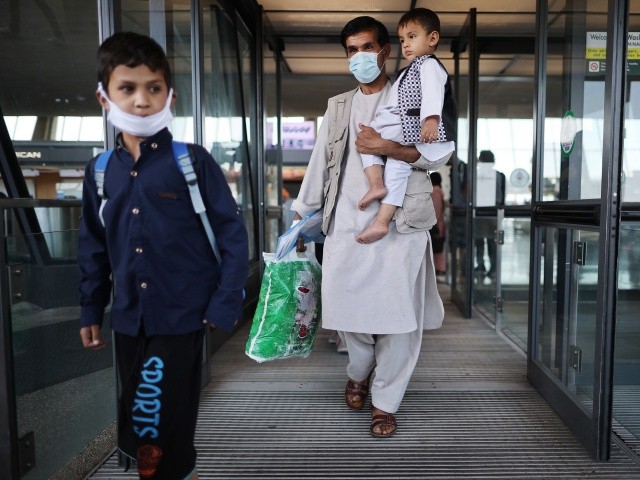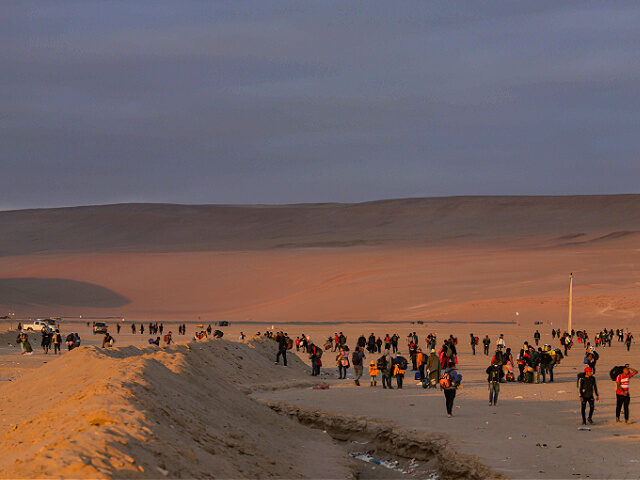Peruvian officials on Sunday announced they had intercepted 23 Afghans in the custody of migrant traffickers operating along the border with Brazil. The migrants included four children, one of them a two-month-old baby.
Peruvian prosecutors said the Afghan migrants paid the traffickers to take them across Peru and into Ecuador, but they were cheated out of their money and abandoned in a packed village house with no food.
“The Afghans were led to believe they would be transferred to a regional city, then on to the capital Lima before heading to Tumbes, a city near Peru’s northern border with Ecuador,” Voice of America News (VOA) reported.
Afghanistan’s Khaama Press quoted Peruvian officials saying the migrants “must have given huge sums of money” to the “coyote” smugglers, but they did not specify the amount.

In this Aug. 15, 2021 file photo, Taliban fighters take control of Afghan presidential palace in Kabul, Afghanistan, after President Ashraf Ghani fled the country. (AP Photo/Zabi Karimi, File)
“Since the return of the Taliban to power in August 2021, Afghan people have unprecedentedly migrated to the neighboring countries and beyond, mostly due to economic reasons, fearing death threats and persecution by the ruling regime,” Khaama Press noted, citing reports of Afghans undertaking risky nautical journeys to the Canary Islands and Spain.
Reuters reported in February that a pipeline for hundreds of Afghan migrants begins in Brazil, which is willing to grant humanitarian visas to refugees from the Taliban’s brutal misrule. The migrants then undertake a “perilous trek overland through Latin America across at least 11 countries” before “jumping onto U.S. soil.”
“Hundreds of people each month are risking their lives to get there on a human smuggling route notorious for kidnapping, robbery and assault. U.S. border agents apprehended 2,132 Afghans last year – a close to 30-fold increase over the prior year – with nearly half arriving in November and December, U.S. government data show,” the report noted.
The Toronto Star reported in March that a similar pipeline has been created from Brazil to Canada. As one refugee explained, “It takes years to get your asylum papers approved in the U.S. Why not Canada, which accepts immigrants and processes their papers quickly?”
The United Nations refugee agency, UNHCR, describes Afghans as “one of the largest refugee populations worldwide.” About 2.6 million Afghans fled the country, while another 3.5 million are internally displaced.

Refugees arrive at Dulles International Airport after being evacuated from Kabul following the takeover by the Taliban of Afghanistan August 27, 2021, in Dulles, Virginia. (Photo by Chip Somodevilla/Getty Images)
Many of the refugees fled across the border into Pakistan and Iran but they have experienced great difficulty with obtaining long-term refugee status or permanent citizenship in those countries. Pakistan has lately been denying citizenship even to Afghan men who marry Pakistani women, an arrangement that formerly conferred nearly automatic citizenship status upon the men.
Many also say they have difficulty making a living in Pakistan or Iran, so fleeing to Latin America and paying coyote smugglers for transportation becomes an appealing alternative. Human smuggling is a booming industry within Afghanistan itself, as smugglers say Taliban security personnel are fairly easy to bribe and Pakistani drivers work cheaply. Iran is a trickier destination because it has a serious border fence, and Iranian drivers command much higher prices for ferrying loads of illegal migrants over the border.
Every angle for escaping from the Taliban is dangerous. In addition to being preyed upon by smugglers, as the migrants in Peru were, the escape routes stretch over dangerous terrain along the Iranian border and hazardous sea routes for those who reach the coasts.

COMMENTS
Please let us know if you're having issues with commenting.